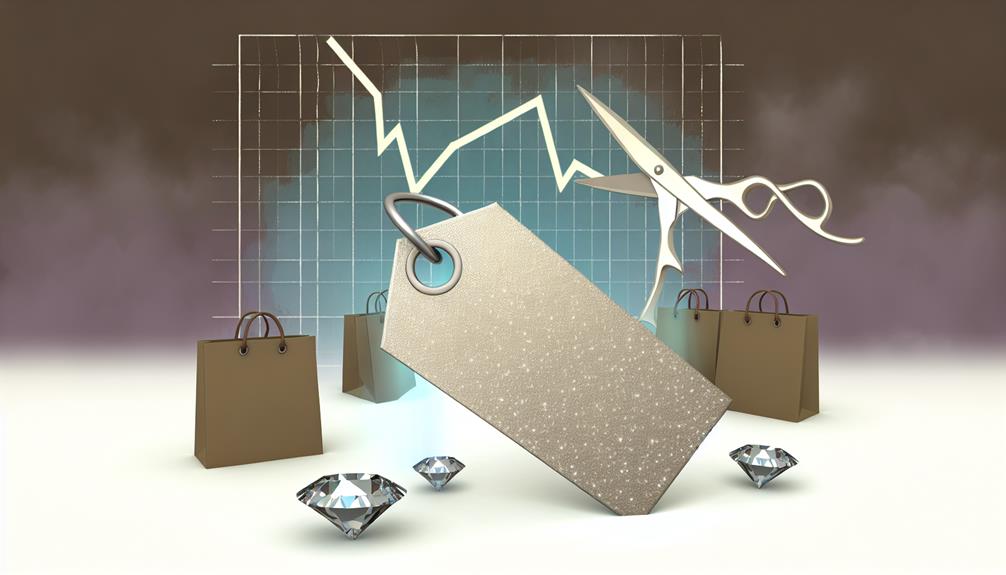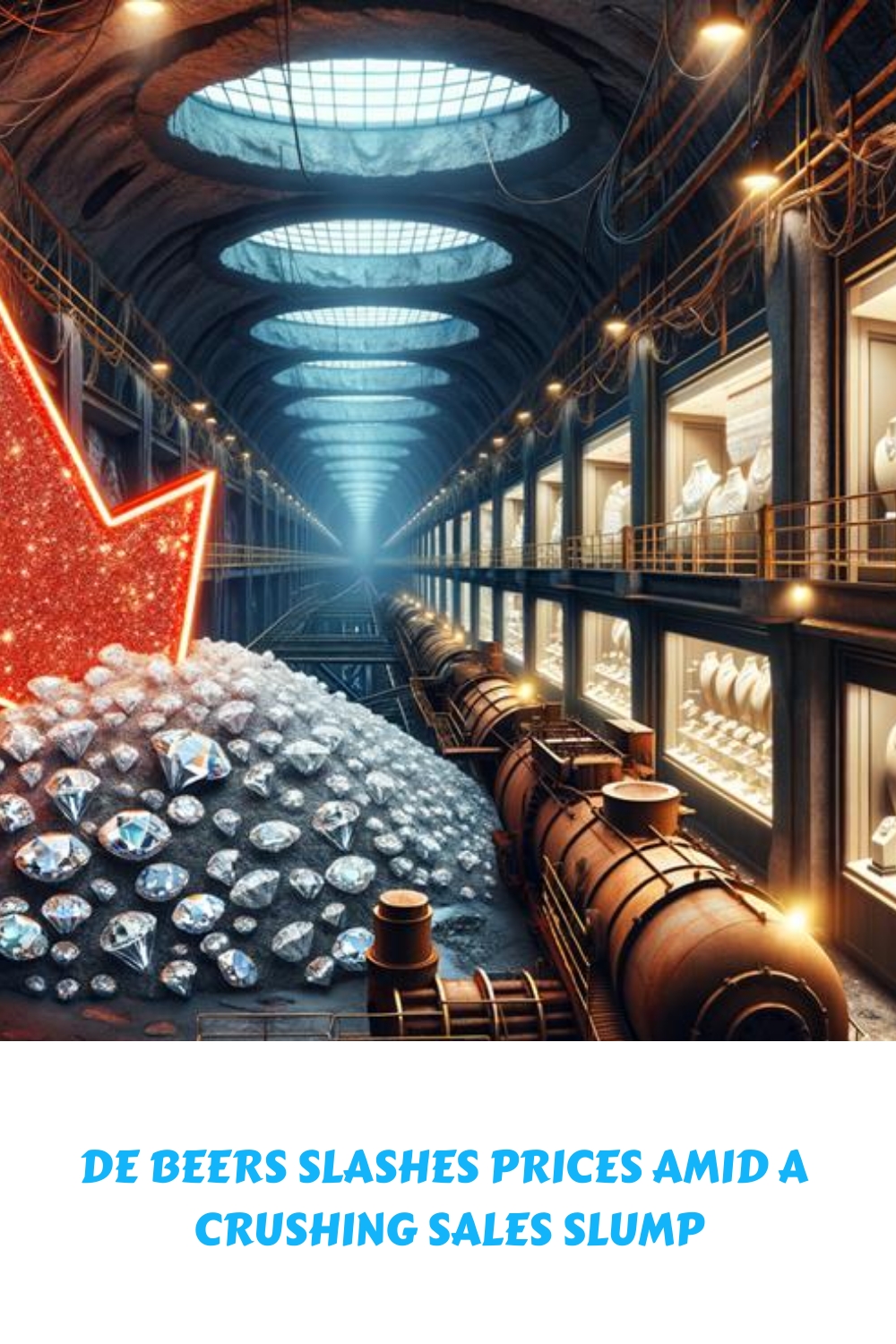In a climate where economic headwinds buffet even the most established of luxury sectors, De Beers’ recent decision to reduce diamond prices signals a significant shift in the company’s strategy to navigate the current market turbulence.
As the diamond industry grapples with softening demand and the rising popularity of synthetic alternatives, De Beers’ price cuts reflect a broader trend of adaptation within the realm of high-end commodities.
The implications of this move extend beyond immediate revenue concerns, suggesting potential ripple effects throughout the global diamond supply chain and consumer purchase patterns.
With the firm’s reductions poised to recalibrate the perceived value of these coveted gemstones, industry observers and stakeholders await with anticipation to gauge the full impact of this development.
The question remains: will this pricing strategy restore the lustre to De Beers’ sales figures, or is it indicative of deeper shifts that could reshape the diamond market as we know it?
Article Contents
- 1 Key Takeaways on De Beers Diamond Price Cuts
- 2 De Beers’ Pricing Strategy
- 3 Factors Driving Sales Decline
- 4 Impact on Diamond Industry
- 5 Consumer Shifts to Lab-Grown
- 6 Future Implications for De Beers
- 7 Frequently Asked Questions
- 8 Our Conclusions About the De Beers Diamond Price Cuts
- 9 De Beers Slashes Prices of Diamonds: Further Reading
Key Takeaways on De Beers Diamond Price Cuts
- De Beers has strategically reduced diamond prices by up to 25% in order to boost consumer confidence and revitalize the market.
- The price cuts reflect De Beers’ recognition of changing consumer preferences and increased competition in the diamond industry.
- These reductions are the most significant seen in recent years and indicate De Beers’ urgency to address inventory accumulation and stimulate sales.
- The price cuts may set a precedent for other players in the market and reshape the industry’s pricing standards and competitive landscape.
De Beers’ Pricing Strategy
De Beers has strategically reduced prices within the select makeables category by up to 25% in a decisive manoeuvre to counteract the prevailing sales challenges. This highlights a significant shift in their pricing approach amid increased competition and changing consumer preferences.
The term “makeable” is used by diamond cutters and jewellers to describe a rough diamond that can be profitably manufactured into a polished diamond.
As the world’s largest diamond company, De Beers’ price reductions reflect a calculated effort to bolster consumer confidence and rejuvenate the market. The market has shown signs of fatigue due to an oversupply of diamonds and the economic impact of the pandemic.
The move to cut diamond prices, particularly within a category that has historically commanded premium pricing due to its relevance in bridal jewellery, underscores De Beers’ acknowledgement of the shifting landscape. The growing popularity of synthetic diamonds has also played a role in prompting De Beers to adjust its strategy.
These price cuts, the most substantial seen in recent years, indicate the company’s urgency to address inventory accumulation and stimulate sales.
Factors Driving Sales Decline
A confluence of factors, including the ascent of lab-grown diamonds, a glut in supply, and economic pressures in key markets, has precipitated a notable downturn in natural diamond sales. The industry faces a complex challenge as it navigates through a milieu of evolving consumer preferences and macroeconomic headwinds.

The following points offer a deeper insight into the multi-faceted nature of the sales decline:
- The rise in competition from lab-grown diamonds has introduced a cost-effective alternative, luring away customers who traditionally opted for natural stones.
- Weak demand for luxury goods, exacerbated by a slowing global economy, has dampened the appetite for high-value items such as diamonds.
- A property crisis in China, coupled with broader economic uncertainty, has led to a contraction in one of the largest markets for diamond jewellery.
- An excess of rough diamonds adds to the industry’s difficulties by creating inventory backlogs and pressure on prices.
This analytical breakdown highlights the intricate interplay between market forces and industry-specific dynamics. The shift towards synthetic diamonds, market saturation, and external economic factors are reshaping the landscape for natural diamonds, influencing De Beers’ strategic response to the current sales slump.
Impact on Diamond Industry
De Beers’ recent price reduction strategy vividly illustrates the broader ramifications for the diamond industry, which now grapples with the task of stabilizing the market and restoring consumer confidence amidst unprecedented challenges. By implementing a significant price cut, De Beers aims to revive gem sales, which have been suffering due to a combination of factors, including weak demand and competition from lab-grown diamonds.
The impact of De Beers’ decision to reduce prices on the diamond industry cannot be overstated. These price cuts reflect the struggle to maintain market share in the face of the rising popularity of cheaper, lab-grown alternatives and the need to adjust to global economic shifts, such as high inflation rates that affect luxury goods markets. The price reduction, especially within the select makeables category, is an aggressive move, indicating that the industry is willing to take decisive action to prevent a further decline in natural diamond valuations.
Furthermore, the De Beers cuts diamond prices strategy signals a pivotal moment for the industry, which must now reassess its value proposition to consumers. The price cut may set a precedent, potentially prompting other players in the market to follow suit, thus reshaping the industry’s pricing standards and competitive landscape.
Consumer Shifts to Lab-Grown
As consumers increasingly prioritize both cost-effectiveness and ethical considerations, lab-grown diamonds have emerged as a popular alternative to their mined counterparts, significantly impacting the traditional diamond market. The demand for lab-grown diamonds reflects a broader consumer shift that challenges the established norms of the diamond industry. These synthetic gems offer a compelling value proposition, presenting both affordability and a smaller environmental footprint. The labgrown diamond market slowdown has forced traditional diamond retailers to adapt their business models to compete with the rising popularity of synthetic diamonds. Additionally, the ethical concerns surrounding the mining industry have pushed consumers to consider lab-grown diamonds as a more socially responsible choice. As a result, the traditional diamond market is facing increasing pressure to meet the changing demands of conscious consumers.
Key factors driving consumer preference towards lab-grown diamonds include:
- Cost Advantage: Lab-grown diamonds provide substantial savings, typically costing 60% to 85% less than mined diamonds.
- Ethical Appeal: Consumers are drawn to the ethical assurances associated with lab-grown diamonds, which do not carry the same concerns about conflict or exploitation.
- Quality and Similarity: With advancements in technology, lab-grown diamonds are virtually indistinguishable from their mined counterparts to the naked eye.
- Market Dynamics: The diamond industry faces pressure to curb supply amid too much inventory and a need to reinvigorate demand.
This trend presents a challenge for traditional diamond miners, as they must adapt to a market that is increasingly receptive to lab-grown options. The diamond industry’s response, including De Beers’ decision to reduce prices, reflects an imperative to align with evolving consumer values and market conditions.
Future Implications for De Beers
The strategic decision by De Beers to reduce diamond prices may set a precedent for the future of the natural diamond market and influence the company’s ability to maintain its leading position amidst evolving consumer preferences and competitive pressures. As De Beers cuts diamond prices, it navigates a complex landscape of economic uncertainty and shifting market dynamics. The efforts helped the market by potentially stimulating demand. Yet, it remains unclear how much appetite exists for natural diamonds in a world increasingly attracted to alternatives such as lab-grown stones.
Analysts will be observing whether these cuts will help in the long run, as De Beers aims to stem a collapse in sales and restore equilibrium between supply and demand. The company’s pricing strategy could have broader implications, possibly triggering a recalibration of value perception among consumers and within the industry. The effectiveness of these measures to revive De Beers’ fortunes is not assured, and their impact on the company’s market dominance is yet to be determined.
In the quest to retain relevance and profitability, De Beers’ agility in responding to both economic headwinds and consumer trends will be critical. How the diamond giant adapts to these changes will define its trajectory and potentially reshape the industry’s future landscape.
Frequently Asked Questions
What Is the Controversy With De Beers?
The De Beers controversy primarily relates to its historical market dominance and alleged price manipulation.
As the once predominant force in the diamond industry, De Beers has faced criticism for creating an artificial scarcity to control diamond prices.
Moreover, ethical concerns about ‘conflict diamonds’ and competition from lab-grown diamonds have further complicated its market position, challenging the company’s pricing strategies and corporate practices in the evolving gemstone landscape.
How Did De Beers Cartel Try to Maintain Control of the Price in the Diamond Market?
De Beers has historically employed several strategies to maintain control over diamond market prices. One key strategy is managing supply by stockpiling diamonds and strategically adjusting production levels. By doing so, they can ensure that the availability of diamonds aligns with market demand, thereby stabilizing prices.
In addition to managing supply, De Beers has also focused on marketing efforts. These efforts have played a crucial role in sustaining the perceived value of diamonds, further supporting price control.
Why Has De Beers Dominance in the Diamond Market Lessened in Recent Decades?
De Beers’ dominance in the diamond market has waned due to several factors.
The rise in synthetic diamond production has provided consumers with less expensive alternatives.
Additionally, increased competition from other mining companies has further eroded De Beers’ market share.
Regulatory changes and ethical concerns about diamond sourcing have also compelled buyers to consider other options.
These elements have substantially diminished De Beers’ once unassailable position in the industry.
Why Is De Beers so Expensive?
De Beers’ historically high prices are often attributed to their once dominant market position, which allowed for control over supply to maintain price levels.
Numerous marketing campaigns that portray diamonds as expensive items and representations of love and commitment also support their premium pricing strategy.
Additionally, the cost and complexity of diamond mining and distribution contribute to the final retail price of their products.
Our Conclusions About the De Beers Diamond Price Cuts
The strategic reduction in diamond prices by De Beers reflects a proactive response to shifting market conditions. By adjusting prices, particularly in the bridal segment, the company aims to stimulate demand and maintain its competitive edge.
This move highlights the broader industry’s need to adapt to economic pressures and consumer preferences, including the growing acceptance of lab-grown alternatives.
The long-term implications for De Beers and the diamond industry hinge on the effectiveness of such adaptive strategies in a changing market landscape.
De Beers Slashes Prices of Diamonds: Further Reading
1: NY Post: https://nypost.com/2024/01/15/business/diamond-prices-slashed-up-to-25-as-sales-slump/
2: Business of Fashion: https://www.businessoffashion.com/news/luxury/de-beers-cuts-diamond-prices-to-revive-sales/
3: Bloomberg: https://www.bloomberg.com/news/articles/2024-01-15/de-beers-cuts-diamond-prices-to-get-sales-going-again
4: Rio Times Online: https://www.riotimesonline.com/diamond-giant-de-beers-cuts-diamond-prices-amid-sales-slump/
5: The Robb Report: https://robbreport.com/style/jewelry/de-beers-cuts-diamond-prices-1235475357/






